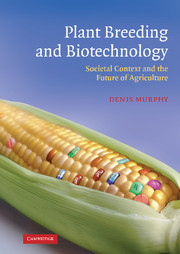Book contents
- Frontmatter
- Contents
- Preface
- Acknowledgements
- Using this book
- Nomenclature and terminology
- Abbreviations and glossary
- Introduction
- Part I The science of plant breeding
- Part II The societal context of plant breeding
- Part III Turmoil and transition: the legacy of the 1980s
- Part IV The agbiotech paradigm
- Part V Increasing global crop production: the new challenges
- Part VI Plant breeding in the twenty-first century
- 16 The future of international plant breeding
- 17 Rebalancing our approach to crop improvement
- 18 Where do we go from here?
- 19 Conclusions and recommendations
- Notes
- References
- Index
16 - The future of international plant breeding
Published online by Cambridge University Press: 07 May 2010
- Frontmatter
- Contents
- Preface
- Acknowledgements
- Using this book
- Nomenclature and terminology
- Abbreviations and glossary
- Introduction
- Part I The science of plant breeding
- Part II The societal context of plant breeding
- Part III Turmoil and transition: the legacy of the 1980s
- Part IV The agbiotech paradigm
- Part V Increasing global crop production: the new challenges
- Part VI Plant breeding in the twenty-first century
- 16 The future of international plant breeding
- 17 Rebalancing our approach to crop improvement
- 18 Where do we go from here?
- 19 Conclusions and recommendations
- Notes
- References
- Index
Summary
Give fools their gold, and knaves their power;
Let fortune's bubbles rise and fall;
Who sows a field, or trains a flower,
Or plants a tree, is more than all.
John Greenleaf Whittier (1807–1892) A Song of HarvestIntroduction
In this chapter, we consider some of the challenges facing both public and private sector plant breeding, as we move into the post-privatisation era of the early twenty-first century. For example, given the increasingly parlous state of public sector breeding, should the private sector now be considered as a major future provider of breeding-related R&D? After all, this already happens in other key areas of the economy. Nearly all pharmaceuticals are researched, developed and marketed by private companies that often enjoy near-monopoly status in their supply to consumers. In richer countries, these expensive products are generally disseminated, cheaply or freely, via taxpayer funded healthcare systems. If the public is willing to subsidise private sector dominance of the provision of life-saving drugs, why should our food supply be any different? The answer is that the current pharmaceutical industry paradigm is proving deeply flawed, especially in supplying cost-effective drugs to poorer consumers.
A particular problem with the present organisation of the pharmaceutical industry is that cash-poor governments in many developing countries cannot subsidise sales of expensive drugs to the poor. This becomes a serious issue with a major disease like AIDS, where the cost of medication is beyond the reach of most sufferers and the state.
- Type
- Chapter
- Information
- Plant Breeding and BiotechnologySocietal Context and the Future of Agriculture, pp. 241 - 263Publisher: Cambridge University PressPrint publication year: 2007



